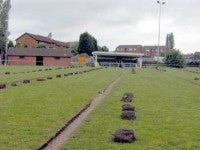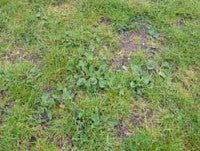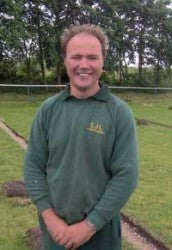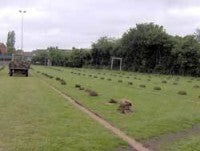Improving pitch playability.
Improving pitch playability
By Laurence Gale MSc

In my time I have seen many examples of poor quality pitches. In the main, this has been caused by the lack of regular appropriate pitch maintenance, poor construction or lack of adequate primary or secondary drainage.
Most clubs generally manage to mow and mark out their pitches, but do little else. Aeration, feeding, weeding and end of season renovations are rarely carried out due to cost or lack of understanding of the benefits of doing these operations.
So, it is not surprising that over time the standard of these pitches begins to deteriorate. The soil profile becomes compacted, often exacerbated by other factors such as the lack of adequate drainage.
The main contributing factor to a decline in pitch quality is insufficient, ongoing maintenance funds. Clubs often have to rely on the goodwill of members to carry out the maintenance tasks, using limited equipment.
In recent years some clubs have managed to secure funding from sports' governing bodies to upgrade or make pitch improvements. This is welcome - however, there is a need to ensure adequate pitch maintenance is planned, budgeted for and carried out.
Heath Hayes Football Club near Cannock in Staffordshire is one such example. They secured £15,000 from the Football Foundation and Coalfield Regeneration Trust for pitch improvements. The Club enlisted the services of agronomist George Attwood-Harris of Sports Turf Consultancy Associates to provide a feasibility study for improving the pitch quality.
The ground was laid down many years ago and was built up on land reclaimed from the coal mining industry.
In recent years, the pitch had suffered from waterlogging. The reason was clear, there was no primary or secondary drainage systems and a lack of regular maintenance in terms of aeration, weeding and feeding. This is a common problem seen on many club pitches.
The net result was a pitch that deteriorated in wet weather. An indication of the severely compacted ground was the area running
The club was recommended to install a primary drainage system and put in place a workable maintenance regime to enhance the sward quality.
A number of sports turf drainage companies were invited to tender for the provision of a primary drainage system and some aftercare maintenance.
The club selected a local contractor from Uttoxeter, SJL Landscapes. A family firm, headed up by Simon Large, who had been a Golf course Manager at Uttoxeter for the last 25 years. Simon has competed several drainage jobs locally and has all his own trenching and pipe laying equipment.
Turf was stripped from the drainage runs and stacked nearby for re-use. A trenching machine was then used to cut the drainage runs cutting out a single run down the length of the pitch with a fall of 1-100m for the main drain. The machine cut a trench 300mm wide and 600mm deep, 100mm diameter land flex pipes was used for the main drain, backfilled with 20-13mm clean, rounded stone and 
75mm piped laterals were installed at 5-metre centres (20 in total) inserted at 450mm with a fall of 0.5-60m.
At least that was the plan, with Simon allowing a week to complete all the work.
However, this industry always likes to give you a challenge, in this case, quite a heavy challenge. Even though pilot holes had been dug in several locations to ascertain the soil type and depth for drainage, the site revealed some interesting problems.
Simon usually expects to dig out a 50m pipe run in 1 hour with his trencher, but found that heavy amounts of bedrock were being uncovered, resulting in many hours spent with a jackhammer digging through them to enable the trenching machine to lay the pipe. In fact, in one part of the scheme over 4.5 tonnes of rock had to be removed. These heavy deposits of rock added another three days to the job, which has been one of the hardest digs Simon has ever encountered.
The combination of the extra days, the recent dry weather and the fact that there were no watering facilities available meant that the turf had dried up so much it had become unusable, making it impractical to put back. Simon will now top the drainage runs with a 50 /50 sand soil rootzone and overseed with a perennial dwarf ryegrass mixture.
A further 20 tonnes of top dressing materials will be spread over the whole pitch, which will be fertilised and overseeded. The success of germination and establishment with only 6 weeks to go prior to the first match will be heavily dependent on the weather and the inputs from the club.
Simon is keen to discuss and implement a suitable maintenance regime to ensure that the pitch has the chance to fulfil its potential
This will involve an increased level of maintenance, focussing on good aeration, mowing and fertiliser regimes, which this pitch has not had in the past.
A similar picture can be seen on many other club pitches. Many clubs tend to focus on issues other than the pitch itself. Valuable resources are spent on providing barriers, floodlights and dugouts to comply with league rules, Many clubs after they have paid out there weekly running costs, rent, ref expenses, player kit expenses etc are not left with much money for other services, which in turn means in most cases the pitch is the last item on their agenda. Often there is very little maintenance other than some mowing and marking out.
Having seen the demise of maintenance standards, particularly on parks and club and school pitches in recent years, there is an urgent need to promote appropriate pitch maintenance. Well over 80% of pitches I inspect and consult on have asked for my help with problems that turn out to be caused by poor maintenance standards.
The Industry does have Playing Quality Standards such as these, which were developed by the IOG and National Playing Fields Association. They provide guidance of what the pitches should aspire and perform too. However, these standards will never be met until a minimum standard of annual maintenance is ratified and agreed by the sports governing bodies.
Football Pitch Growth and Playing capabilities
|
PERFORMANCE PROPERTY |
Basic Standard |
Average Standard |
|
|
1 |
Length of herbage mm |
20-70 |
20-60 |
|
2 |
Top soil depth mm |
100 |
150 |
|
3 |
Root depth mm |
75 |
100 |
|
4 |
Thatch depth mm |
15 |
10 |
|
5 |
Casting worms % |
10 |
5 |
|
6 |
Pest % |
2 |
0 |
|
Disease % |
2 |
2 |
|
|
7 |
Ground cover % |
75 |
85 |
|
8 |
Bare area % |
25 |
15 |
|
9 |
Weed cover % |
10 |
2 |
|
10 |
Algae/lichen/moss % |
2 |
0 |
|
11 |
Undesirable grass species % Poa annua % |
30 10 |
20 5 |
|
12 |
Desirable grass species % |
60 |
70 |
|
13 |
Evenness (variation in mm under a 3 metre straight edge) |
25 |
18 |
|
Debris(litter) |
nil |
nil |
|
|
Uniformity of Appearance% |
90 |
70 |
|
|
Uniformity of colour % |
90 |
70 |
It is essential for the sports turf industry to agree and set down a minimum maintenance regime for maintaining football pitches. These inputs will include several maintenance operations that are essential for maintaining and promoting a healthy natural grass sward playing surface that should meet the PQS standards.
The regime will include guidance on the amount of materials to be used and frequency of operations, including recommendations on height of cut and depth of aeration required for a annual maintenance programme prescribed for maintaining a single senior size football pitch.
In my opinion the following minimum maintenance inputs should be undertaken when maintaining a natural grass football pitch. Obviously, climatic weather conditions, soil type, usage and whether the soil profile is free draining will play a significant part in the out come of the maintenance inputs. However, we do need to formalize some minimal inputs to achieve a level playing field.
In practice each club should have its own specific programme designed for its individual circumstances. However, these suggestions will make a good starting point. Once a programme is underway it can be refined to achieve the best results, perhaps with help from a sports pitch consultant who can carry out the necessary performance quality assessments.
Proposed minimum maintenance regime for football
| Input | Frequency | Comments |
| Grass Cutting cylinder / rotary mowers cutting height between 25-35mm | Minimum of 30 cuts per year | Ideally mowing on a 4-7 day cycle |
| Aeration Using verti drain or spiker or slitter | Minimum 6 times per year | Depth between 150-300mWhen conditions allow |
| Harrowing / Raking Using harrows and spring tine rakes | Minimum 6 times per year | |
| Fertilising Application of Spring, Summer and Autumn fertilisers | Allowing for 3 applications per year | Applying a balanced programme of NPK fertilisers to meet the needs of the grass plant. |
| Weed control Using chemical selective herbicides to control broad leaf weeds in turf | Allow for 1 application of herbicide per year | |
| Line Marking Using approved line marking equipment and materials. | Initial and over marking.Allow for overmarking approx 30 home games | |
| Watering Not all facilities have water available for irrigation, however during renovations there may be a need to irrigate newly sown turf. | Allow provision for watering and the cost for water resources. Equipment and manpower. | |
|
End of season renovations
Repair worn areas cultivate level and overseed. Verti drain the whole pitch (6000m2). Restore levels by top dressing the pitch with between 60-100 tonnes of approved sand / soil top dressings. Overseed the whole pitch area (6000m2) with approved grass seed species for sports turf. Drag harrow / brush the whole pitch to work in the top dressings and seed. |
One operation usually completed after the last match has been played.
|
Based on current commercial contractor costings the above operations, based on a single pitch facility would cost in the region of £10.000-£15000 for supplying labour, equipment and materials. Obviously costs can be reduced if much of the work is done by club members and equipment purchased as a capital expenditure, spread over a period of three years plus. Costs per pitch will also reduce if there is more than one pitch receiving the same work.
It is essential that clubs are made aware of the maintenance regimes required to produce a quality playing pitch, whilst at the same time understand why these operations are required.
About one third to half of the above costs could be saved if the clubs were to invest in providing themselves with the basic machinery, labour (particularly volunteered) and equipment to carry out many of these basic tasks.
A small compact tractor with aerator and mowing gangs coupled with a line marker and cyclone spreader would enable the club to carry out these basic maintenance inputs themselves, with the ability to hire in specialist companies to carry out the end of season renovations.

This would send out a clear message to all pitch providers - that they must provide a certain level of maintenance to ensure the provision of a well-prepared playing surface.
Clubs, schools, and local authorities should allocate enough money and resources to ensure that the pitches they manage fulfill the desires and expectations of the users, providing a level, true and safe playing surface that can accommodate the sport being played and the ability of the players.
If we want to support, promote and raise the levels of sport participation in the UK it is essential that the sports governing bodies agree and make available the necessary resources to achieve the aim of providing a level playing field.
George Attwood-Harris is particularly keen to see improved funding for pitch maintenance. "The Football Foundation funding is too often grossly disproportionately focussed on improving changing rooms and providing kit at the expense of pitch quality" he said.
Contacts:
SJL Landscapes
Simon Large
Elford Cottage
Heath Road
Uttoxeter
ST14 7LX
07751 402452
Heath Hayes Football Club
John Deans
280 Hednesford Road
Heath Hayes
Cannock
Staffordshire
WS12 3DS
01543 378181 or 07980 991409
STCA
George Attwood-Harris
01782 515679 or 07712 779473
